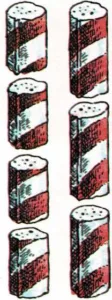Bigger is smaller
If someone asked you whether you would rather have three peppermint
sticks or four peppermint sticks, you’d answer “four,” of course. Four
is more than three.
But what if someone asked whether you’d rather have one-fourth of a
peppermint stick or one-third? What would you answer to that?
Well, first you would have to know what one-fourth and one-third are. If
you broke a peppermint stick into pieces, each piece would be one-part
of the whole stick. If you broke the stick into four equal pieces, each
piece would be one-fourth. If you broke it into three equal pieces, each
would be one-third.
Fourths and thirds—and fifths and sixths and so on—are fractions.
Fraction means “broken,” and that’s what fractions are— broken pieces
of a number. We can show fractions with words, such as one-fifth, or
with numerals, such as ■§-. Both mean the same thing.
If you said that you’d rather have one-third (-J-) of a peppermint stick
than one-fourth (\|), you would be right. When you are counting, four is
more than three, but when you’re using fractions, one-fourth is
smaller than one-third.
See for yourself. Here’s a peppermint stick that’s broken into thirds,
and one that’s broken into fourths. As you can see, thirds are bigger
than fourths.
In fractions, the bigger a number is, the smaller the piece is. A
sixteenth is much, much smaller than a sixth. And a hundredth is ten
times smaller than a tenth!


